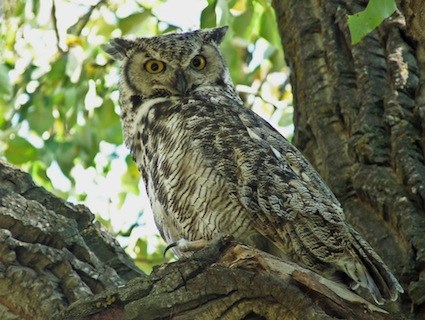 A couple of months ago, we started noticing an owl calling when we returned home in the evening. He seemed to be in the tall trees behind our house. One night, we saw him perched on the roof of our garage. When we approached him, he just sat there and stared back at us. We mentally adopted him as one of our yard pets.
A couple of months ago, we started noticing an owl calling when we returned home in the evening. He seemed to be in the tall trees behind our house. One night, we saw him perched on the roof of our garage. When we approached him, he just sat there and stared back at us. We mentally adopted him as one of our yard pets.Weeks later, Mr. Owl took to sitting on the vacant martin house and on other low perches in the yard. He appeared to enjoy watching us as much as we liked watching him.
Then a week ago when hubby let the dog out at night, the magnificent creature was statuesquely sitting on the gatepost about five feet from the back porch. He just sat there staring at us as we took pictures of him. His large, golden-orange eyes were studying us intently. It was one of those nature moments that you never expect to have.
Over the next few days, the owl sat on the ground, and even when we walked up to him, he didn’t move. We called an owl rescuer and a wildlife biologist to find out how to care for him. The next day he died. After examining him, the biologist said that there was no evidence of injury or any physical problem.
Great Horned Owls, also called Hoot Owls, Cat Owls, or Winged Tiger Owls, live to about fifteen years in the wild and longer in captivity. The tufts of feathers on their heads appear to be horns or ears, but they have nothing to do with hearing. Weighing about five pounds and measuring from eighteen to twenty-five inches tall, they can have a wingspan of from three to five feet.
These birds of prey perch on high places and silently swoop down on their victims which may include rabbits, mice, or on occasion even small cats or dogs. They also eat animals on the ground like snakes, fish, and frogs. One of the few animals that will eat a skunk, the owl can capture prey two or three times heavier than they are. Their binocular vision allows them to pinpoint their prey, and their heads and eyes can rotate 270 degrees.
A curious feature of the species is the owl’s stomach which contains an area in which the indigestible portions of what they eat like fur, feathers, teeth, and bones are compacted into a pellet which the owl regurgitates later. Studying this pellet can enable biologists to find out many things.
Owls are highly adaptable and live in a variety of settings in North, South, and Central America. They use the vacant nests of other birds such as hawks, crows, or herons. Mating in January and February, both the male and female take turns sitting on the nest.
We feel fortunate to have had the opportunity to observe closely this marvelous creature. We would like to think he felt like he was at home.
No comments:
Post a Comment